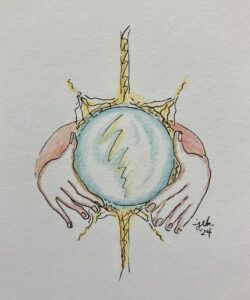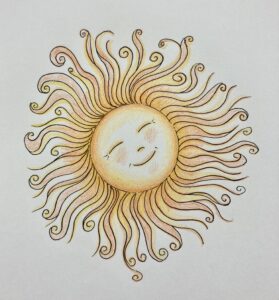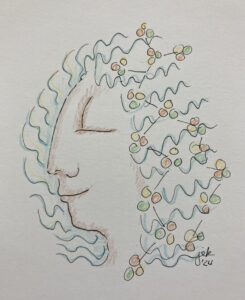
-Artwork © 2024 Jan Ketchel
Shamans call the inner critic a foreign installation, programmed to overshadow the true nature of our magical beingness. Rather than bask in the awe of our unlimited potential it causes us to stew in the murky waters of unworthiness and inadequacy.
The foreign installation delivers an inner dialogue that judges incessantly. The voice might sound like our own, but this is a kind of AI stunt. The voice is impersonal and it afflicts every human being with its negative messaging.
On a personal level, this internal dialogue delivers constant suggestions to the subconscious mind that manifest in powerfully negative moods and beliefs about the self. The way to neutralize the effects of this program is to reprogram the subconscious mind.
One major pitfall in dealing with the inner critic is to try to reason with it. It’s very tempting to stand up to the critic, but be forewarned. However receptive it may be, it is programmed only to defeat. Beware of its reasonableness and encouragement, it’s merely another opportunity to ultimately steal your positive energy through greater defeat and humiliation.
Another highly effective tactic of the inner critic is to trap us in feeling resentment for being offended by the words and actions of others. It is indeed necessary to take action when one is victimized, but the holding of resentment entrenches one in deeply negative thought and feeling, as the inner critic perseverates in its negative messaging.
Note the mechanism that the inner critic utilizes to achieve its decisive influence: the non-stop flow of negative suggestions to the subconscious mind. Rather than attempt to prove your worthiness to the critic, deliver your own constructive, positive messages to the subconscious mind.
Here’s an institutionalized example of negative messaging. Just prior to receiving communion with God, during a Catholic mass, this prayer is repeated three times: “Lord I am not worthy to receive You, speak but the word and my soul will be healed.” The message delivered: I am not worthy, I am undeserving, and I require you to heal me.
This disempowering messaging could be reprogrammed, as follows: “I am worthy. I intend to be healed.”
These suggestions, delivered to the magical center of the subconscious mind, generate positive self regard, acknowledge the power of the conscious mind to use its words to initiate a healing, and have faith in the subconscious mind to manifest a healing.
Rather than argue with an impersonal program, copy its highly effective strategy. State positive suggestions to the subconscious mind often. The subconscious will eventually pick up the consistent messaging of your suggestions and manifest their intent.
Of course, the new suggestions will be competing with powerful programs established by years of the foreign installation’s internal dialogue. These old programs generate blocking beliefs that compete with new suggestions. Have faith in ultimate success and perseveringly, and with passion, state your suggestions.
Sometimes, we might argue that some of what the inner critic highlights is true, so we can’t really believe the affirmations we’re stating. Face the truth of habits or behaviors that sabotage the self. Rather than berate the self, take steps to address these issues. While addressing these issues continue to state your positive intentions for the self. Feel love versus disappointment for the self, regardless of its foibles.
Finally, don’t attach to the outcome, which means don’t try to imagine or plan how things will work out, just trust that they will. Exercise faith. Faith is the knowing that you are a magical being capable of creating a fulfilling life through the marriage of your conscious mind that designs the blueprint, with your subconscious mind that sculpts your intent.
Rather than passively allow a foreign installation to construct your life, create your own masterpiece. State aloud or write down your intent, fix an image of that intent firmly in your mind’s eye, and constantly reaffirm your intent with positive affirmations to yourself.
Trust that your beloved partner, your subconscious mind, will follow the necessary path, however long and winding, to manifest your heartfelt intent.
Hold faithfully to the image you have designed, knowing that every day is presenting you with circumstances that require decisions and actions, the building blocks of your already-in-progress, created, new life.
In construction,
Chuck



